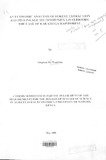| dc.description.abstract | Forests and other tree systems in Africa continue to play an important role in the national
economies and livelihoods of the rural population. They constitute an important
component of household food security by providing fuel wood. The indigenous forests
provide a wide range of use and non-use goods and services to local communities. These
include food (vegetables, fruits and roots), medicinal plants, house construction materials,
fuel wood, wildlife habitat, and other environmental and ecological functions. Forest
extraction is not only putting the provision of these goods and services at risk but is also
likely to lead to loss of livelihood to local communities as well as loss of forest
biodiversity.
This study assesses the types and quantities of direct non-timber forest products (NTFPs)
extracted by the local people living around the Kakamega Forest in Western Kenya. It
further analyses the factors that influence a household's decision to participate in NTFPs'
collection and the level of extraction undertaken.
The results of this study are derived from a random sample of 370 households who were
interviewed using a semi-structured questionnaire. The quantities of the different
products obtained by extracting households are valued at the average market prices to
obtain their financial values. The results of the study indicate that the forest generates a
substantial economic value to the local people. It was found that this value is comparable
to that of some common crop enterprises in the research area.
A Heckman two-stage regression model is used to analyze the socio-economic,
institutional, and geo-physical factors that influence household's decision to participate in
forest extraction and the level of extraction chosen by the household. Proximity to the
forest edge, the form of forest management approach, education level of the household
head, and participation in forest conservation activities are the main factors influencing
the household decision to extract NTFPs from the forest. The level of extraction for the
participating households is influenced by their proximity to the forest, the household size
and participation in forest conservation activities.
The study concludes by highlighting some important policy inferences for sustainable
use and conservation of Kakamega Forest. These include involvement of the
communities living adjacent to the forests in forest conservation activities and the
implementation of strategies that improve their livelihoods to reduce over-reliance on the
forest resources. | en |

